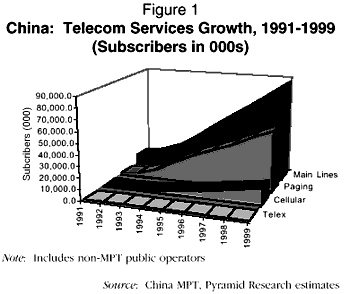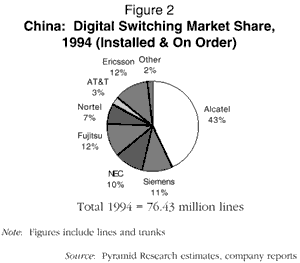
The MPT has had to reconsider its development strategy in the face of expected competition from Unicom, which gained the right in 1994 to compete with the MPT in all areas of telecommunications operations. Unicom has the backing of three powerful ministries within the Chinese central government -- the Ministry of Railways (MOR), the Ministry of Electronic Industries (MEI), and the Ministry of Electric Power (MEP) -- as well as 13 other important Chinese investors. The operator came into existence thanks to tremendous political pressure exerted by these three Ministries:
Unicom's total initial capitalization stands at $154 million (RMB 1.34 billion). As of mid-1995, Unicom has invested an estimated $82 million (RMB 700 million) in network installation.
Unicom has extensive plans to install a nationwide trunk network, based on the private networks of its investors. However, the operator is initially focusing on cellular networks, and has been a driving force behind the spread of the digital Global System for Mobile (GSM) Communications cellular standard in China. Revenues from Unicom's cellular networks -- which now number 16 and are expected to double this year -- will then be funneled back into fixed network development.
The MPT now faces additional competition in a wide variety of secondary telecommunications services. In late 1993, nine "value-added" service segments, including radio paging, 450 MHz and 800 MHz mobile radio services, and VSAT network operation, were officially opened to non-MPT operators. The market opening directive merely formalized what was already taking place: Hundreds of non-MPT paging operators had been selling pagers to the public through back channels. There are now over 1,700 licensed non-MPT paging operators in China, a factor which has certainly contributed to the boom in subscribership; China had a total of 17.66 million paging subscribers at the end of 1994, and over 26 million at the end of 1995. While the boom in other liberalized services has not been as significant, it marks a move toward opening the market.

Unicom also has a set of extremely ambitious network development plans, although it is far from clear that these will be fulfilled in the planned timeframe. Unicom is expected to become a significant purchaser of public network transmission equipment from 1996 on, with sales picking up significantly after 1997 as the carrier builds-out its national long distance network. Unicom trunk switching purchases will also pick up during this time period. By the year 2000, Unicom aims to have 2.4 million to three million mobile subscribers (roughly 30% of the MPT's expected national total), to provide 10% of national long distance services, and to raise China's telephone penetration rate by one percentage point. Unicom plans to provide approximately 300,000 users with fixed line telephone service in more than 10 major cities. By the year 2000, Unicom hopes to generate $1.8 billion in assets and $600 million in revenues.
One area of China's public network equipment development which has yet to see significant growth is rural networks. China's rural population of 800 million has been seriously under-served, with funds for rural network development taking the back seat to flashier projects such as trial ISDN networks and digital cellular operations. Rural lines nearly doubled during the Eighth Five-Year Plan period, but still accounted for less than 26% of all switching capacity in China at the end of 1994. The MPT leaves most rural network planning to local and provincial authorities. Rural areas are generally strapped for cash, and rural Post & Telecommunications Bureaus (PTBs) have a reputation for accumulating bad debt, making them less-than-popular customers. Rural networks will continue to grow far more slowly than urban networks, but will gain more MPT attention during the Ninth Five-Year Plan period.
The GSM digital cellular standard is another technology which made a late appearance in China but has rapidly become accepted nationwide. China's cellular subscribership has been more than doubling annually since the first networks were cut over in the 1980s, but virtually all networks utilized the MPT-approved TACS analog standard, and the need for more frequency-efficient digital cellular networks was clear. The GSM digital standard, which is used throughout the rest of Asia, was introduced by the Guangdong Provincial Post & Telecommunications Administration (PTA) in 1994, without having been approved by the MPT. GSM has since become the de facto national cellular standard, with GSM networks being installed by dozens of PTAs as well as by second operator Unicom.
The local loop also presents important opportunities for new technologies, given the number of subscriber lines the MPT plans to install under the Ninth Five-Year Plan. Virtually all local loop installations in China thusfar have been copper wire, but there will be opportunities for both fiber optic access and wireless local loop (WLL) access over the next several years. As China's more developed cities ramp up broadband networks, fiber optic access will spread to an estimated 1.85 million subscribers by 1999. Meanwhile, WLL, which is being heavily pushed by suppliers to local PTBs, is expected to be implemented on a wide scale by second operator Unicom, which has rights to part of the AMPS cellular frequency band and has already stated its intention of using the frequency for WLL. The MPT is also expected to begin implementing various forms of WLL for both rural and urban applications, and will trial several major suppliers' WLL solutions in 1996.
The MPT and provincial PTAs have been building out the national packet-switched network, ChinaPac, since 1992. Northern Telecom is providing the backbone nodes for ChinaPac, which already has over 10,000 users, and will ultimately have 5,500 nodes covering all major cities in China.
ChinaDDN began construction in 1993. Digital data networks have spread like wildfire in China, with hundreds of local and provincial PTBs and PTAs constructing their own digital data networks to interconnect with the national data network backbone. Both ChinaPac and ChinaDDN also serve as platforms for Internet services.
Currently, Internet access is available to roughly 30,000 subscribers in China; by the end of 1996, the MPT expects availability to extend to 150,000 users. The country's first Internet link was set up in 1988, and a number of university-based Internet connections followed. China's first commercial Internet service, ChinaNet, was cut over in April 1995. ChinaNet uses the ChinaPac network and allows users to make international 64 Kb/s and 256 Kb/s Internet connections via Sprint's SprintLink service. Dallas-based AsiaInfo Services is serving as systems integrator for the recently-announced expansion of ChinaNet. The network is scheduled to have 31 nodes covering all provinces and municipalities by mid-1996, and will be one of the world's largest wide-area computer networks. CERNET, another major Internet project, is a major educational network centered at Qinghua University. CERNET is managed by the Chinese State Education Commission; planned investment in the network is $9.6 million over the 1993-1996 period. ChinaDDN will serve as the platform for CERNET.
Alongside the MPT networks, the Ministry of Electronic Industries, through JiTong Communications Corporation, is undertaking construction of the "Golden Bridge" VSAT-based ISDN backbone. JiTong plans to invest $11.8 million (RMB 100 million) in the network over the 1994-1997 period. Golden Bridge, which will be interconnected with the MPT data networks, will support a variety of datacom services, including e-mail and electronic data interchange (EDI), at speeds ranging from 144 Kb/s to 2 Mb/s. Plans call for 300 VSATs to interconnect a vast array of state and private information networks nationwide. The Golden Bridge network will eventually be connected to the Internet via satellite.

The level of competition has also made financing a key ingredient for vendors interested in selling to the MPT or its local and provincial level subsidiaries. The ability to provide favorable financing terms, whether through government soft loans, installment payment plans, or other means, has meant the difference between winning and losing contracts for all of the major suppliers. Suppliers have, however, found their financing options increasingly curtailed over the past several years.
Accompanying the growth in competition has been the increase in joint venture production of public network equipment. All foreign switching suppliers have set up local production of switching, subsequent to (and in some cases even preceding) the MPT's decision to formally permit them to enter the market. Similarly, most significant foreign manufacturers of fiber optic transmission equipment are in the process of setting up joint manufacturing ventures that will be capable of producing SDH multiplexers. These will allow suppliers to bypass some of the restrictions on imports of foreign equipment, although the joint ventures themselves have been subject to contradictory regulations from the Chinese government. In principle, the Chinese government encourages all foreign suppliers to set up joint venture production facilities as part of its eventual goal of shifting all telecom equipment purchases to local producers rather than importing equipment. However, the government has permitted certain companies to import equipment duty-free, while charging the joint ventures for importing the parts needed to assemble equipment in China. As a result, during 1994 and part of 1995, it was more expensive for customers to purchase from the joint ventures than to import equipment.
In addition, locally-designed switching and transmission equipment is beginning to take a significant share of China's telecom market. After years of unsuccessful experiments with locally-designed digital central office exchanges, several models have developed enough to become viable alternatives to foreign-designed switches in areas where price is of greater concern than 100% reliability. These models now make up over three million lines of China's installed public switching capacity, primarily in rural areas and smaller cities. On the transmission side, Chinese low-capacity microwave equipment is spreading rapidly, particularly in rural areas, although foreign suppliers maintain that the quality of the equipment is in no way comparable to that of imported technology.
Local manufacturers, which include both MEI- and MPT-affiliated factories as well as privately-held facilities, are being strongly encouraged by the Chinese government to raise production capacity and compete with foreign suppliers. Their aggressive stance has driven down overall market prices for public network equipment significantly over the past year, and will continue to keep prices low through the analysis period.
In addition, several consortia have been formed to foster cooperation among Chinese manufacturers and keep prices from dropping to unprofitable levels. Eight state-run manufacturers have been grouped into the China Great Dragon Telecommunications Group Co., which was registered in March 1995. The group expects to produce 3.5 million lines in 1996. On the mobile front, the Golden Cellular consortium is a collection of mobile equipment manufacturers which aims to establish a foothold for Chinese suppliers in the mobile handset and, eventually, infrastructure markets.
The move toward localization of production -- both through joint ventures and through the development of China's own telecom equipment models -- is inevitable given the sheer size of market demand. A growing proportion of the equipment in both public and private networks will be locally manufactured. It will be some time, however, before the technical level and reliability of Chinese-designed equipment makes it a true competitor to foreign-designed central office switching and transmission equipment.
Localization, combined with continued competition, will have the attendant effect of exerting downward pressure on equipment prices. There has already been some backlash from foreign equipment suppliers tired of cutting prices and profit margins to unacceptably low levels; for example, several suppliers have begun bidding less aggressively on MPT SDH transmission contracts because the winning bids always came in at prices too low to turn a profit. Nevertheless, for most suppliers, the size of the Chinese market, and the prestige of being known as a leading vendor in China, will make winning worthwhile regardless of what is needed.
Authors' Note: Pyramid Research is a telecommunications market research and consulting firm based in Cambridge, Massachusetts and Singapore. The information in this article was drawn from the Pyramid Research study, Telecommunications Markets in China (February 1996).